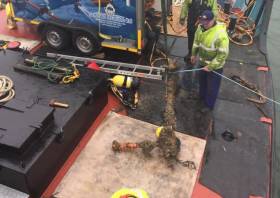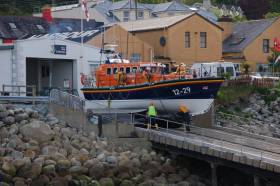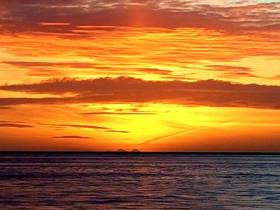Displaying items by tag: Carlingford Lough
Anchor ‘Lost From Sailing Ship Over 100 Years Ago’ Recovered From Carlingford Lough
The Facebook page for Carlingford Lough has shared a remarkable find from the lough by subsea divers — an anchor believed to have been lost from a sailing ship more than a century ago.
It’s understood the anchor was discovered as it was causing an obstruction in the shipping channel close to Warrenpoint Harbour.
Afloat.ie awaits further updates as to the anchor’s origins.
Haulbowline: Famous Lighthouse Illuminated in Memory of People Who Died in Carlingford Lough
Near the border of Northern Ireland and the Republic sits a famous lighthouse which has been illuminated in memory of people who have died in Carlingford Lough.
The Haulbowline Lighthouse, writes the Irish Examiner, is situated on the Lough, separating Co Louth and Co Down, and is thought to be the first and only lighthouse in Ireland and the UK to be externally illuminated.
The 34-metre tall lighthouse will remain lit up for the month of August to remember all those who have lost their lives there.
Carlingford Lough experienced its worst maritime disaster in 1916 when a coalship collided with a passenger ferry bound for Holyhead out of Greenore.
The disaster claimed the lives of 97 people, including passengers and crew. Only one person, a fireman on the collier, survived.
Click here for more on this story.
Lifeboats from Clogherhead, Newcastle and Kilkeel were involved in the search for a woman missing in Carlingford Lough at the weekend, which came to a sad end yesterday afternoon (Monday 18 March) with the discovery of a body in the water off Greenore.
Newcastle RNLI was tasked to divert from a morning training exercise on the Co Down coast to join the major search operation which began on Sunday (17 March), concentrating on the entrance to Carlingford Lough and outlying islands.
During this search the all-weather lifeboat located a casualty in the water and, working with volunteer lifeboat crews from Clogherhead and Kilkeel RNLI, the casualty was taken ashore to Greenore Harbour by the Kilkeel lifeboat and placed in the care of An Garda Síochána.
The casualty was shortly after confirmed to be the remains of Ruth Maguire from Newcastle, who went missing during a hen party in Carlingford on Saturday night (16 March).
Speaking following the search, Newcastle RNLI coxswain Nathan Leneghan said: “On behalf of Newcastle RNLI I wish to express our deepest sympathy to the family and friends of the woman who was recovered from the water this afternoon.
“The thoughts and prayers of the everyone involved in the search are with them at this sad time. I also wish to commend the volunteer crews for their commitment and professionalism.”
Kilkeel RNLI lifeboat operations manager John Fisher added: “This was not the outcome we or the family wanted and at this difficult time our thoughts and prayers are with the family and friends of the casualty.
“At this time I would also like to thank the volunteer crew for their commitment and energy. We train for such an incident but always pray that it has a better outcome.”
Skipper On Carlingford Lough Ferry Shares Amazing View of Holyhead
#ferrynews - The operator Scenic Carlingford Ferry have shared an amazing view this week of Holyhead in Wales, as captured in a photo by the ferry's skipper Ivan.
This stunning view, The Dundalk Democrat features, shows two mounds of land in the distance, according to the Skipper, this is Holyhead where the ferryport Afloat adds on Holy Island itself lies off the west coast of the larger Isle of Anglesey.
A beautiful sight as the darkest day of the year draws closer to tomorrow's winter solstice.
Public Take 'Saga-Selfies' As Cruiseship Makes Return Call to Warrenpoint
#cruiseliners - Warrenpoint Harbour welcomed the return call of a cruiseship to the Co. Down port that first launched this trade in recent years, writes Jehan Ashmore.
Saga Pearl II had arrived into the scenic surroundings of Carlingford Lough last week having among its all-Ireland ports of call included Cobh, Cork Harbour.
The southern port this year had its first cruiseship, Saga Pearl II as Afloat previously reported.. The photo supplied for that coverage was actually that of her namesake predecessor, Saga Pearl which currently operates for other another company.
At just 18,000 gross tonnes, Saga Pearl II has the advantage of getting to visit smaller and lesser well known ports in Ireland and the UK as part of cruise itinerary also launched in recent years. This allows Saga cruisegoers to reach destinations that most giant cruiseships cannot.
On this rare occasion of a cruiseship call, Warrenpoint Harbour Authority organised a special public opening of the port through the Town Dock Office. This was to enable the public to gain access to view Saga Pearl II. Previously the cruiseship's historic first port visit in 2014 also drew in the crowds.
The public on this latest call were encouraged to get a 'Saga-Selfie' with the background of the cruiseship described by owners as a small yacht-like ship. With no more than 449 passengers on board and reserved exclusively as an adults-only ship.
There are seven passenger decks. Across these decks are facilities that include a small cinema, gymnasium, spa, hair and beauty salon, library, shop, card room and a
launderette.
#ferry - The Sunday Times writes that the head of the newest Republic-Northern Ireland transportation link has urged a speedy resolution to the Brexit border question.
A ferry began crossing Carlingford Lough on Friday with the 15-minute journey promising a boost for local tourism and business.
Bad weather rather than paperwork delayed the inaugural service but Pamela Houston, the chief executive, said that an unimpeded frontier should endure after the UK left the European Union. “We are a frictionless border, I think people are used to that. I think it is good for business,” Ms Houston said.
She added that people were used to taking travel documents when they flew and added that a duty-free shop could create opportunities for her company.
#Ferry - The much-awaited Scenic Carlingford Ferry appears to be inching closer to launching as news that navigational lights are in the process of being installed out on Carlingford Lough.
In a statement on their Facebook page Scenic Carlingford Ferry stated that they will release a further update next week and thanked everyone for their patience.
"Good news, the bespoke navigational lights have arrived and we are beginning to install them. They are mounted on steel piles, so we might be spotted out on the Lough fixing everything into position.
For more The Dundalk Democrat has a report here.
#FerryWickow - A newly renamed car ferry Frazer Aisling Gabrielle called to Wicklow Port prior to the opening of the new Scenic Carlingford Ferry that is scheduled to begin operations early next month, writes Jehan Ashmore.
The 44 car capacity Frazer Aisling Gabrielle had arrived to Wicklow yesterday evening after a passage of around 10 hours from Waterford Estuary. The car ferry having received work at New Ross Boat Yard in preparation for the new service linking Greenore, Co. Louth and Greencastle in Co. Down.
The work carried out at the inland yard downriver from the Port of New Ross involved a new livery applied to the ferry formerly named Foyle Venture. Under that guise this ferry has previously called to Wicklow Port. As such the presence of the car ferry was less of a surprise in Wicklow unlike newbuild Spirit of Rathlin that made a unique call to Greystones in February of this year.
Frazer Ailsing Gabrielle which can accommodate 300 passengers had berthed at Wicklow's East Pier from where a crew rest took place overnight. An inshore fishing boat, Bernice set off from the North Quay this morning to transfer a pilot on board the carferry. Following that the vessel departed in classy calm seas for the final leg of the voyage bound for Greenore.
The ferry project on Carlingford Lough cost €9.75 million (£8.5 million) was entirely privately financed and developed by the Frazer Ferries Group. They acquired last year the Passage East Ferry Company that operates on the Waterford Estuary route served by F.B.D. Tintern.
The former Lough Foyle ferry however provided relief duties to allow the smaller car ferry that plies between Passage East and Ballyhack to undergo annual maintenance at the facility in New Ross.
New Carlingford Lough Car Ferry Ready to Set Sail
#NewService - A new car ferry service is ready to be rolled out on Carlingford Lough in June this year, according to operating company Scenic Carlingford Ferry.
The ferry company writes The Dundalk Democrat made the announcement via their website: "The new cross border vehicular ferry service will link Greenore and Greencastle in Co Down across the iconic Carlingford Lough and will commence operations in June. The works are already attracting large numbers of visitors to view the progress.
"This project, which has taken almost 10 years to bring to fruition, will be one of the most strategic infrastructure investments in the region. The €9.75 million (£8.5 million) project is entirely privately financed and is being developed by Frazer Ferries Group.
"This will be the first vehicular ferry across Carlingford Lough. The previous two ferries having carried passengers only. The first ferry was recorded in 1185 AD and sailed between the medieval castles at Carlingford and Greencastle, then was followed by the Greenore Greencastle ferry which carried the first “tourists”, during the 19th century.
To read more on the development, click here.
New Route: Ferry On Carlingford Lough To Sail This Year
#NewRoute - A ferry service which has been long awaited between Greenore and Greencastle, linking both sides of Carlingford Lough, will launch early this summer, writes the Argus.
'Construction work has commenced and we're planning to have the ferry service operational by the early part of the summer,' said Paul O'Sullivan of Carlingford Lough Ferries.
The project, which is estimated to have the potential to create 300 jobs directly and indirectly, was first mooted a decade ago but faced numerous delays due to objections, particularly on the northern side.
'It has taken eight or nine years to get to this point in time but we had two jurisdictions to deal with, so we had to double up on everything - planning applications, marine licences, environmental studies, as well as dealing with two sets of statutory bodies,' said Mr O'Sullivan.
To read more the newspaper has a report here.





































































